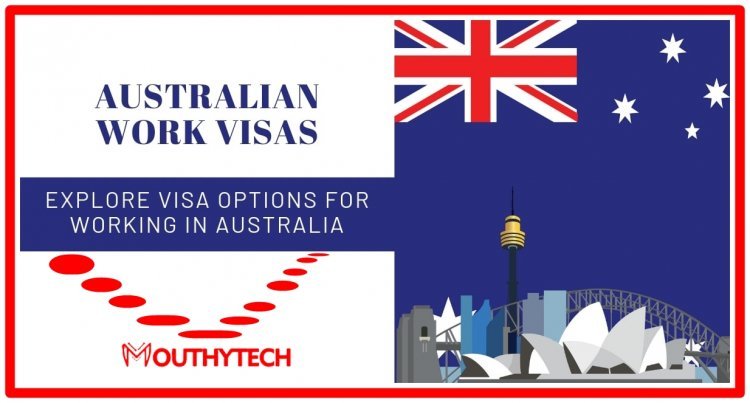The Ultimate Guide to Getting a Work Permit and Visa for Australia
If you’re considering relocating to Australia, you may have heard about the requirements and process for obtaining a visa or work permit. You may have questions, but have been unable to find the answers you need from your friends and family members or sources online, so you’ve decided to do some more research before moving forward with any plans you have. If that sounds like you, then this ultimate guide to getting a work permit and visa for Australia will cover everything that you need to know.

For most of us, the thought of working abroad and exploring another country’s culture and lifestyle sounds like a fantastic experience! And it can be, but it isn’t always easy to get there! To live and work in Australia, you’ll need to obtain a Work Permit and Visa from the Australian government. This can seem like an intimidating task, but it doesn’t have to be that way! If you are ready to explore your options and learn what it takes to make this happen, continue reading!
What is Visa
If you want to work in Australia, you will need a Temporary visa. You can then apply for Permanent residence or citizenship. There are many different visas, but they all come with restrictions and eligibility requirements. This cannot be very clear, so here is an overview of the two main types: Temporary visas are granted upon entry into the country, and Permanent visas must be applied for before entering.
Introduction
Do you dream of living and working in Australia? If so, this guide will help you learn how to get your work permit and visa. You can only apply for a Temporary Skill Shortage (TSS) visa if you have an offer of employment from an Australian employer willing to sponsor your application. Once approved, the TSS visa temporarily allows someone to live and work in Australia. It does not provide a pathway to permanent residency or citizenship. For more information on becoming eligible for a TSS visa, see below •How do I qualify for a TSS visa?
To be eligible for a TSS visa, you must:
- -Have the qualifications and skills that are needed by an Australian business;
- -Be under 45 years old;
- -Meet health requirements;
- -Possess good character.
What is a Work visa
A work visa is an endorsement by the country of employment that allows an individual to work legally in that country. To get one, you will need your employer's sponsorship letter; if you are from outside the EU, you will also need a temporary skills assessment certificate. You can apply online or at the nearest Australian high commission or consulate. A permit will take up to four weeks to process and a visa up to two months, so it is best not to leave these until the last minute!
A Temporary Skill Assessment Certificate (TSAC) verifies your qualifications against Australia’s skilled occupation list.
If you are a worker looking to apply for an Australian visa, the Commonwealth country offers a variety of visa types for professionals. Some of these visas can even lead to temporary or permanent residency for you and eligible family members.
You could also obtain a visa through Australia’s immigration point system. You will find the specifics of this covered in this section, along with Australia’s visa application and process for each type of permit. Plus, all the information you need on visa requirements and visa fees for Australia.
Work Permits and Employment-Based Visas
Australia offers work permits and employment-based visas for different types of expert workers moving to Australia for job-related purposes. Some of the work visas for skilled professionals include the following list.
Types of Work Permits for Australia
- Employer Nomination Scheme (ENS) visa – allows skilled workers nominated by their employer to live and work in the country permanently.
- Regional Sponsored Migration Scheme (RSMS) visa – allows skilled workers nominated by their employer in regional Australia to live and work in the country permanently.
- Skilled independent visa – for invited workers and New Zealand citizens with skills Australia needs to live and work permanently anywhere in Australia
- Skilled Nominated visa – Let nominated skilled workers live and work in Australia as permanent residents.
- Temporary Skill Shortage visa – a temporary visa that enables an employer to sponsor a suitably skilled worker when an Australian is not available
- Skilled Regional (Provisional) visa – temporary visa for skilled workers who want to live and work in regional Australia.
- Temporary Work (Short Stay Specialist) visa – a temporary visa lets you do short-term, highly-specialized work in the country.
- Temporary Work (International Relations) visa – temporary visa to work in particular circumstances that improve Australia’s international relations
- Distinguished Talent visa (subclass 858 for applying within Australia or 124 for using outside of Australia) – permanent visa for people with an internationally recognized record of outstanding achievement in a profession, sport, the arts, or academia and research.
In addition to these visas, Australia also has a Business Talent (Permanent) visa, specifically for establishing or developing a new or existing business in Australia. Read more about this type of visa in the Self-Employment Visas section below.
Work visas exist for the following professions:
- skilled workers
- people participating in specific activities
- highly specialized workers
- trainees, short-term
- experienced businesspeople
- investors
If you are unsure which, the visa is the most suitable for you, or if you don’t know how to proceed with your application for an Australian visa, contact our immigration professionals today. They will guide you on all the steps necessary to secure your access successfully.
Australian Work Visa Requirements
The requirements depend on your circumstances and the type of visa you apply for.
The different requirements per category are as follows:
Employer Nomination Scheme (ENS) Visa (Direct Entry Stream)
For the ENS Visa, you must:
- have the skills necessary for the job (skills assessment will be required, with some exemptions).
- be on the relevant list of eligible skilled occupations
- be nominated by an Australian employer.
- meet health (learn more about Australia’s medical exam below) and character requirements.
- have at least competent English
- have at least three years of relevant work experience.
- be under 45 years of age (with some exemptions).
- read or have been explained the Life in Australia booklet, and sign the Australian Values Statement.
Who Can Apply?
How do I apply? You will need to complete a General Skilled Migration application with the Department of Immigration and Border Protection. You will be assessed according to your skills, qualifications, English language ability, education, work experience, age, and suitability for the occupation in Australia you nominate on your application form and then matched against job vacancies in that occupation. There are additional rules regarding which occupations can apply from within or outside Australia.
Tier 1 Visa (Subclass 186)
When you have secured your offer of employment, it's time to apply for your Tier 1 (Subclass 186) visa. This is the first step in getting a work permit, so don't delay. To be eligible for this visa, you must show that no qualified Australians are available or prepared to do the job. Your application will also need to include:
Sufficient funds to support yourself during your stay in Australia
Return airfare for yourself and any dependents coming with you
Documents about where you'll be living in Australia
Evidence of health insurance cover for yourself and any dependents coming with you
The Business Innovation and Investment (Provisional) visa (Subclass 188)
You must first enter the country to get your work permit and visa. Once you have arrived in Australia, go straightaway to your nearest Department of Immigration, which should be listed on the government website. Once there, find the Permits section on their site. At this point, it's best if you fill out an online ENS form before going in person so that they can better help you. You'll also need to make sure you have the following:
-A letter from your prospective employer explaining why they want to hire you (make sure it mentions what position, salary, and benefits)
-A letter from someone who is sponsoring you or willing to act as a guarantor for financial support
-Evidence of enough funds for both yourself and any dependents (show them bank statements with at least 20,000 Australian dollars)
Employer Sponsorship on an Employer Nomination Scheme visa (Subclass 186)
To be eligible to apply under the Employer Sponsorship on an Employer Nomination Scheme visa (Subclass 186) program, you need:
* Completed one year of full-time study in the previous three years. * The sponsorship of an Australian employer willing to take responsibility for your employment conditions and meet the minimum standards set by law. * An offer of ongoing employment with the sponsoring employer in a skilled position that has been identified as being able to be filled by someone with your qualifications. You will also need to show that you have enough money to support yourself while living in Australia. Before applying for this visa, you must also pass a medical examination, security checks, and English language tests.
Family Members on Family visas
Family members can be granted Australian residence based on family reunification. To do this, you will need to meet at least one of the following criteria:
1) You are married or have been in a de facto relationship with an Australian citizen or resident,
2) You are closely related to an Australian citizen or resident,
3) Your children will be dependent on you as their primary carer if they come to live in Australia with you.
4) There is evidence that your marriage or proposed marriage is genuine and was not entered primarily for immigration purposes.
Spouse Visas - Partner, Fiancé/Fiancée, Dependant Child visas
Australia is one of the few countries in the world with relaxed visa requirements for dependant children, meaning that if you apply as an Australian resident or citizen, your child can come to live with you there. The other type of visa available is a Dependant Child visa - these are issued on an ad-hoc basis (a small number each year), so it is important to apply as soon as possible. Applicants will need to provide evidence of the relationship between themselves and their child, such as photos of them together. One thing to note about this type of visa is that it cannot be extended. If the applicant wishes their child to stay longer than 18 months, they must either leave Australia or apply for another type of permanent residence visa for their family member.
Spouse Visas - Prospective Marriage visa
A Prospective Marriage visa is an Australian visa given to those wishing to live in the country, who are engaged or already married, and usually lasts four years. It allows people from any nationality, religion, or age group who are living outside of Australia but wish to move there because they intend on marrying someone who is an Australian citizen or permanent resident entry into the country. There is no requirement for proof of your future spouse's earnings.
Forms may be downloaded from the Department of Immigration website.
When Not To Apply For A Subclass 190 Or Prospective Marriage visa And When To Use Alternatives Instead.
If you enter the country on business, education, or other temporary work, apply for a Subclass 457 visa. If you are trying to enter the country with your spouse, an Australian citizen, or a permanent resident, you should apply under the Prospective Marriage visa category. All others will have to use a different visa category instead. To do this, contact the Department of Immigration and Border Protection (DIBP) for information about applying for: - Tourist visas: tourism visas allow tourists from around the world to visit Australia as long as they leave before their time expires. You can stay in the country for as long as six months.
- Visitor visas: these are designed specifically for travelers who want to stay in Australia temporarily while conducting short-term business or visiting friends and family members there.
Australian Working Holiday Maker Visas
The Australian Working Holiday Maker visa is one of the most popular visas people apply for. It is important to remember that to obtain this visa, you must be between 18-30 years old and hold a valid passport from an eligible country. If you have just finished college or university, this could be the perfect time to get on board with this visa! The next step is finding out which one will suit your needs best. Here are the three types of Australian Working Holiday Visas: Youth Mobility Scheme (for young people who want to experience working abroad), 417 (open work permit for those over 30), and 462 (available work permit under 30).
Other Visas That Can Help You Stay In Australia Long Term For Work Purposes
Once you have your temporary visa, it is also possible to apply for other visas that can help you stay in Australia long term. These include Skilled Independent visa, working holiday maker visa, parent or grandparent visas. The skilled independent visa allows applicants to remain in Australia permanently as long as they earn an income over the required threshold amount.
Working holiday makers are eligible for this visa if they are between 18-30 years old, work in specified industries, and have saved up enough money before coming to Australia.
Parent or Grandparent visas allow parents of Australian citizens or permanent residents to migrate temporarily under the Family Stream category so they can live with their children and grandchildren in Australia.
Official Related Links You Need
You have the best Guide on Immigration, Education, and Employment details for you to Get more out of what you need to know, and it is all free of charge:
Get More Guide - https://bit.ly/ABROAD-IMMIGRATION-CENTER
Immigration - https://bit.ly/IMMIGRATION-CENTER
Education - https://bit.ly/EDUCATION-CENTER
Employment - https://bit.ly/EMPLOYMENT-CENTER
US Immigration - https://bit.ly/US-IMMIGRATION
Final words
To move to Australia, you'll need an Australian work permit. Suppose you are applying for a skilled visa. In that case, your application will be assessed by the Department of Immigration and Border Protection and the Department of Foreign Affairs and Trade.
What's Your Reaction?




















